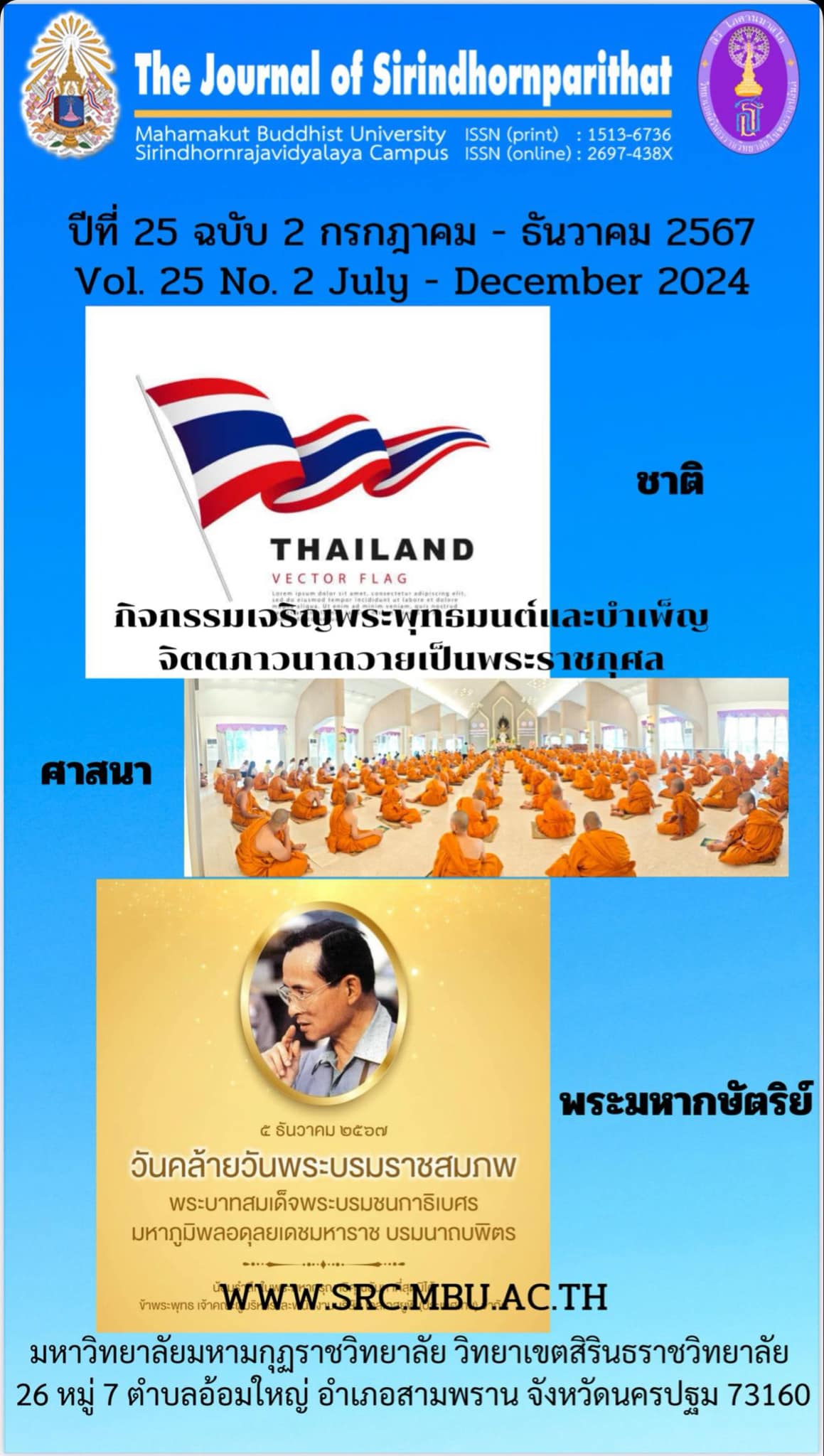Characteristics Of Executives Affecting The Development Of Information Technology In Educational Instional Institutins Under Chonburi Rayong Secondary Education Service Area Office
Keywords:
Managerial Characteristics, Information Technology Development in SchoolsAbstract
The objectives of this research are: 1. To investigate the level of managerial characteristics affiliated with the educational administrative offices of secondary schools in Chonburi and Rayong. 2. To study the level of information technology development within the schools under the educational administrative offices of Chonburi and Rayong.
- To examine the relationship between managerial characteristics and the advancement of information technology within the educational institutions. 4. To explore the managerial characteristics influencing the development of information technology within the schools.
The research sample consisted of 331 teachers from secondary schools affiliated with the educational administrative offices of Chonburi and Rayong in the academic year 2021. The research tools used included surveys and statistical methods such as percentages, means, standard deviations, Pearson's correlation coefficients, and multiple regression analysis.
The findings were as follows:
- Managerial Characteristics: The average level of managerial characteristics within the educational administrative offices of Chonburi and Rayong was high, with ethical and moral qualities being the highest, followed by managerial abilities and vision. Leadership qualities were rated the lowest.
- Information Technology Development: The development of information technology within the schools was rated as high. Teaching and learning processes received the highest average, followed by learning methodologies and learning resources. Cooperation with the public, private sectors, and the community received the lowest average.
- Correlation Analysis: There was a significant positive correlation between the managerial characteristics and the development of information technology within the schools at a statistical significance level of .01.
- Analysis of Managerial Characteristics' Impact: All four dimensions of managerial characteristics significantly influenced the development of information technology within the schools. Vision and leadership qualities had a significant impact, with a predictive power estimated at 60.80%.
References
ณัทชลิดา บุตรดวีงษ์. (2561). การใช้นวัตกรรมและเทคโนโลยีสารสนเทศเพื่อการบริหารสถานศึกษาในศตวรรษที่21ของโรงเรียนแสนสุข สังกัดสำนักงานเขตพื้นที่การศึกษามัธยมศึกษา เขต 18. กรุงเทพ: ปริญญาศึกษาศาสตรมหาบัณฑิต มหาบัณฑิต สาขาวิชาการบริหารการศึกษามหาวิทยาลัยเกริก.
ทวีวรรณ สมาน. (2563). คุณลักษณะผู้นำการเปลี่ยนแปลงของผู้บริหารที่ส่งผลต่อการบริการเทคโนโลยีสารสนเทศ และการสื่อสารสถานศึกษา สังกัดองค์การบริหารส่วนจังหวัดชลบุรี. วารสารครุศาสตร์ปริทรรศน์.
นิศากร กองอุดม. (2562). ความสัมพันธ์ระหว่างคุณลักษณะของผู้บริหารมืออาชีพกับคุณภาพงานวิชาการ ตามความคิดเห็นของครูผู้สอนและผู้บริหารสถานศึกษา สำนักงานเขตพื้นที่การศึกษามัธยม เขต 27. วิทยานิพนธ์ ค.ม. มหาสารคาม. มหาวิทยาลัยราชภัฏมหาสารคาม.
วิลาวัลย์ วัชโรทัย. (2560). คุณลักษณะที่พึงประสงค์ของผู้บริหารสถานศึกษาในยุคดิจิทัลของสถาบันการอาชีวศึกษาภาคกลาง 1 สำนักงานคณะกรรมการการอาชีวศึกษา. คณะศึกษาศาสตรมหาบัณฑิต มหาบัณฑิต สาขาวิชาการบริหารการศึกษามหาวิทยาลัยเกริก.
สำนักงานเลขาธิการสภาการศึกษา. (2553). กฎหมายว่าด้วยการศึกษาแห่งชาติ กฎหมายว่าด้วยระเบียบ. กรุงเทพมหานคร: พริกหวานกราฟฟิค.
สำนักงานเลขาธิการสภาการศึกษา. (2559). การปฏิรูปการศึกษาในทศวรรษที่สอง (พ.ศ.2552-2561). กรุงเทพมหานคร: พริกหวานกราฟฟิค.
อนุชา พลสุด. (2560). ความสัมพันธ์ระหว่างสมรรถนะด้านเทคโนโลยีสารสนเทศและการบริหารระบบสารสนเทศ ของผู้บริหารสถานศึกษา โรงเรียนมัธยมศึกษาในเขตจังหวัดหนองบัวลำภู. หลักสูตรศึกษาศาสตร์มหาบัณฑิต สาขาวิชาการบริหารการศึกษา คณะศึกษาศาสตร์ มหาวิทยาลัยขอนแก่น.
Anderson, R. E. & Dexter, S. L. (2005, January). School technology leadership: An Empirical Investigation of Prevalence and Effect. Educational Administration Quarterly. 41 (1):49 – 82.
Nance, J.P. (2003). Educational Administration Quarterly. Public school administrators. And Technology Policy Making. R. E. & Dexter, S.L.
Andeason. (2000). School technology leadership: Incidence and impact (Teaching, Learming, and Computing: 1998 National Survey Report No.6). Minneapolis: university of Minnesota and the Center for research on Imformation Technology and Organization.
Valdez, Gilbert. (2005). Technology Leadership: Enhanceing Positive EducationalChange. Retrieved December 13, 2005, from http://www.ncrel.org/sdrs/areas/issues/educatrs/ leadrshp/le700.htm. Krejcie, R.V. and Morgan, Daryle W. (1970). Determining Sample Size for Research Activities, from http://www.ncrel.org/sdrs/areas/issues/educatrs/ leadrshp/le700.htm.
Downloads
Published
Issue
Section
License
Copyright (c) 2024 Mahamakut Buddhist University

This work is licensed under a Creative Commons Attribution-NonCommercial-NoDerivatives 4.0 International License.
บทความที่ได้รับการตีพิมพ์เป็นลิขสิทธิ์ของ มหาวิทยาลัยมหามกุฏราชวิทยาลัย วิทยาเขตสิรินธรราชวิทยาลัย
ข้อความที่ปรากฏในบทความแต่ละเรื่องในวารสารวิชาการเล่มนี้เป็นความคิดเห็นส่วนตัวของผู้เขียนแต่ละท่านไม่เกี่ยวข้องกับหาวิทยาลัยมหามกุฏราชวิทยาลัย วิทยาเขตสิรินธรราชวิทยาลัย และคณาจารย์ท่านอื่นๆในมหาวิทยาลัยฯ แต่อย่างใด ความรับผิดชอบองค์ประกอบทั้งหมดของบทความแต่ละเรื่องเป็นของผู้เขียนแต่ละท่าน หากมีความผิดพลาดใดๆ ผู้เขียนแต่ละท่านจะรับผิดชอบบทความของตนเองแต่ผู้เดียว




